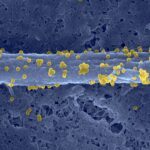Lien vers Pubmed [PMID] – 9669997
EMBO J 1998 Jul; 17(14): 3797-806
Although <50 kb of its 3.3 megabase genome is known, Listeria monocytogenes has received much attention and an impressive amount of data has contributed in raising this bacterium among the best understood intracellular pathogens. The mechanisms that Listeria uses to enter cells, escape from the phagocytic vacuole and spread from one cell to another using an actin-based motility process have been analysed in detail. Several bacterial proteins contributing to these events have been identified, including the invasion proteins internalin A (InlA) and B (InlB), the secreted pore-forming toxin listeriolysin O (LLO) which promotes the escape from the phagocytic vacuole, and the surface protein ActA which is required for actin polymerization and bacterial movement. While LLO and ActA are critical for the infectious process and are not redundant with other listerial proteins, the precise role of InlA and InlB in vivo remains unclear. How InlA, InlB, LLO or ActA interact with the mammalian cells is beginning to be deciphered. The picture that emerges is that this bacterium uses general strategies also used by other invasive bacteria but has evolved a panel of specific tools and tricks to exploit mammalian cell functions. Their study may lead to a better understanding of important questions in cell biology such as ligand receptor signalling and dynamics of actin polymerization in mammalian cells.


